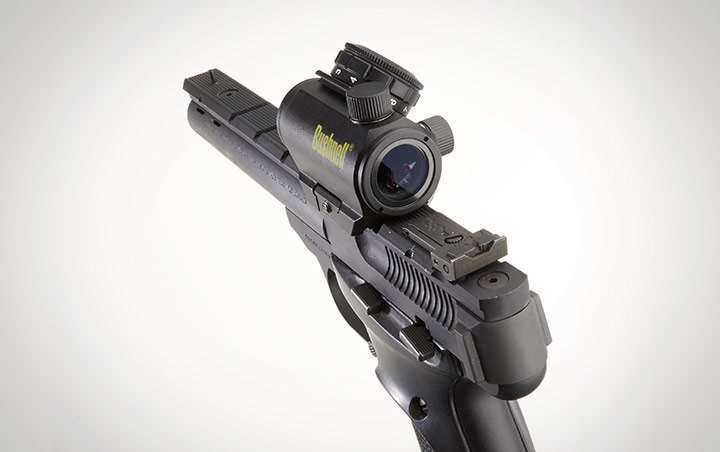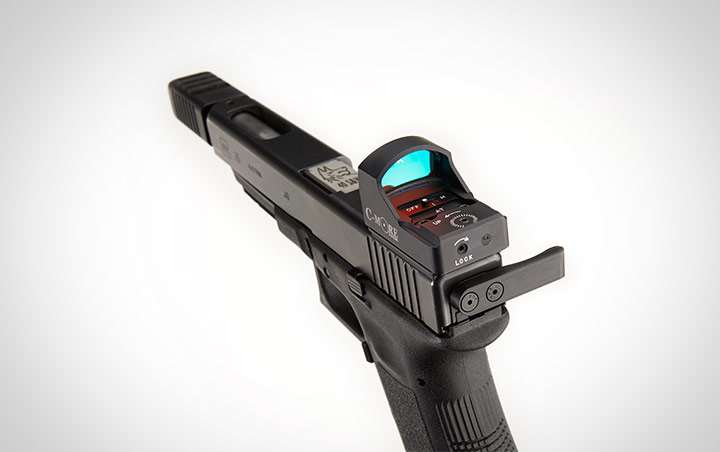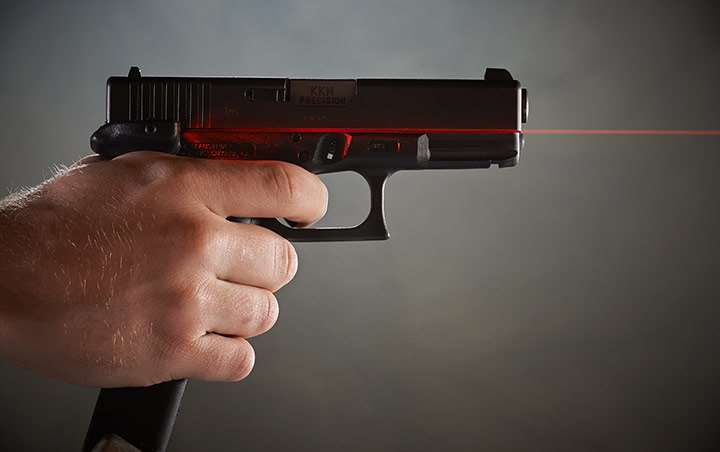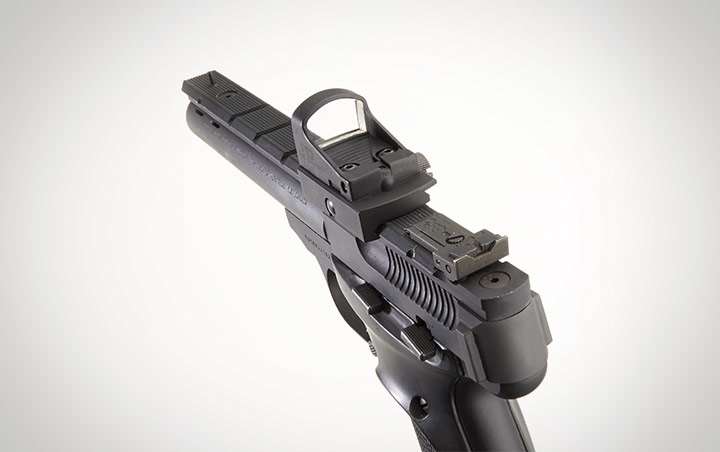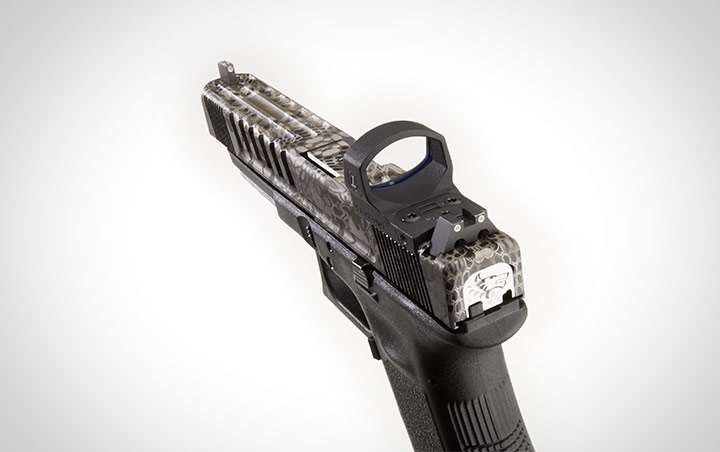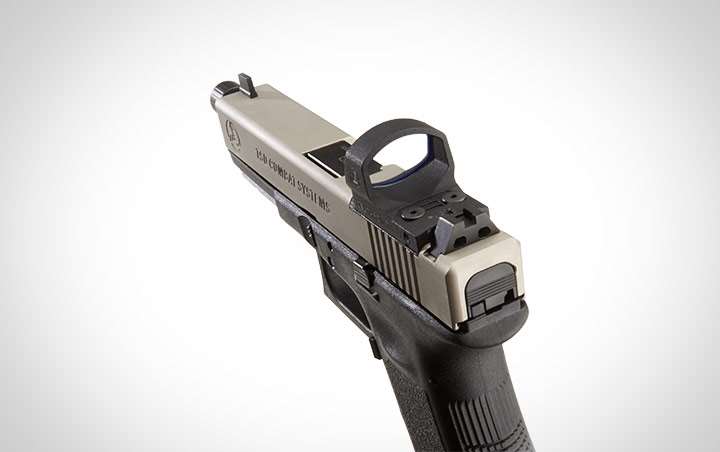
In Parts One and Two of our overview of handgun sight technologies, we’ve seen how innovation has moved notch and post as far as imagination will easily bear. The modern combat or defensive handgunner has choices fit for—or proof against—applications inventor E.E. Patridge did not likely imagine. But if better materials and manufacturing are the beginning, are adaptations from the “outside,” like fiber optics and tritium illumination, the end?
Hardly. But going forward means going back—and in our case, at least 350 years.
How They Work
Sir Isaac Newton demonstrated the optics of light transmission and reflection centuries ago. Simply put, if a light source is placed at the focal point of a properly coated spherical lens, the coating allows a reflection of that light source to reach the eye overlaid on anything else viewed through the lens. There’s a good chance Newton had no way to appreciate the importance of this, but LEDs and button-cell batteries transform this mathematical abstraction into our sought-after next step—the modern “reflex,” or red dot, sight.
The benefits of such a sighting system are manifold. First, the dot (or other reticle shape) need not be meticulously centered or otherwise aligned in the field of the lens: If the reticle appears on target, muzzle alignment is correct (because only the reflected position of the reticle is changed, not the relationship of the light source and the muzzle). Second, the reticle, as it appears to the shooter, is “projected” at infinity (or at least at a distance), and permits the use of conventional eyeglasses, contact lenses, or surgically corrected distance vision with maximum clarity, and between shooters—all without focus adjustment or concerns about eye relief. (This is also a huge aid to learning—or relearning—to shoot with both eyes open, as the brain is essentially not tempted to focus the eyes at different distances, to say nothing of the obvious tactical benefits of retaining both-eyes- open peripheral awareness.) Third, modern materials, manufacturing methods and batteries render these devices astonishingly tough (one of our samples has a 5000g shock rating) and possessed of outstanding endurance (the Aimpoint Electronic, first to use an LED light source circa 1975, had battery life of 1,500 or more hours). Many now have no on/off switch at all, and battery life in excess of 50,000 hours.
Fourth, red dot sights represent a “transitional” sight technology: They have application on pistols (as we’ll see), but also on a wide variety of rifles and shotguns. With generally easy mounting, relatively large adjustment ranges and forgiving eye relief, they’re an easy solution at short and medium ranges.
Last and best: They're fast, fast, fast.
Bushnell TRS-25
The original reflex sights were mostly of a conventional—albeit shortened—tube design, though the optics do not require this. As reflex sights do not magnify a target image, only a single lens is needed. To some extent, this may have been a mounting issue, since tube designs can use standard rings and their associated rails. Our first test sample is such a tube design—the Bushnell TRS-25. Actually, at 2.4 inches in length, it isn’t much of a tube. Still, it’s a gem, and a great way to get a feel—inexpensively—for red dot technology. We’ve used them on a variety of pistols (and rifles) with excellent success. Short as it is, the TRS can’t use conventional rings, but doesn’t need them. An integral Picatinny/Weaver rail makes mounting a snap, though a riser may be necessary in some applications.
The 3 MOA dot reticle is a good compromise. We’d call it smallish for true action shooting, but great for practice at reasonable distances. Unlike some dot sights in the price class, the dot is sufficiently bright for full sunlight, though it doesn’t exactly scream at you. At 22 mm, the exit pupil demands more precise head position when mounted on a handgun, but practice makes perfect in this regard: Hits from low ready on 10-inch plates at 11 yards came easily in .6 of a second with just a little practice, and occasionally much faster.
One consideration for tube designs, even small ones like the TRS-25: On most pistols, you’ll need to consider frame mounting. Even the modest 3.7 ounces has an undesirable effect on balance and reliability in an autoloader if attached directly to a reciprocating slide. If you’ve got a non-moving top rail (like the Browning Buck Mark we tested this on), you’re good to go.
The TRS-25 is a versatile peach, and a modestly priced one at that. We keep one lying around, just for emergencies.
C-MORE
You may not realize it, but you’ve probably seen more C-MOREs than any other tubeless reflex sight. Long a dominant fixture in competitive circles, their Serendipity, Railway and Slide Ride sights are ubiquitous in Open/Unlimited competition classes. Their Scout and Tactical versions are commonplace toppers for on- and off-duty ARs.
For our tests, we put their STS, or “Small Tactical Sight,” on an Open Division (compensated) Glock 35. While the reticle is a conventional—even mundane—7 MOA dot, a host of other well-thought- out features make this a favorite.
First, we like the continuous (that is, “clickless”) and lockable adjustments. It’s nice to know you can get right there, not just close. The 180 inches of elevation adjustment and 120 inches of windage mean if you can’t get sighted in, your gun is bent.
Another great feature is the O-ring-sealed battery tray. While battery life, as we’ve mentioned, is superb on most reflex sights, the tray feature assures that the sight won’t have to be re-zeroed after a battery swap. All kinds of mounting systems make this claim, but we prefer that the claim be unnecessary, as it is with the STS. Remounts = zero.
The little C-MORE trends toward toughness with an aluminum body and glass lens. The latter makes a scratched optic less likely in the long run. We don’t know whether we prefer auto-adjustment of brightness or not, but it’s nice to have the choice. The third switch position allows for the sight to be turned completely off. It’s a small thing, but the cover for the STS fits best of all that have covers.
Shooting tests ran well with the STS. It was on by far the heaviest-recoiling of our test guns, but the mount stayed rock-solid from start to finish, with no hint of drift in the locked adjustments. Although not egregious, the STS still sits higher on the slide than any of our other examples, and this takes a little getting used to.
We sure have the feeling this bad boy is tough—an assertion that will be fun proving or disproving.
When is a Red Dot Not a Red Dot?
When it’s a laser. This is a common confusion for many. With the prevalent (and often inappropriate) use of laser sights in film and television, perhaps it isn’t surprising.
The differences, however, are important. What we’re calling a red dot, or more correctly a reflex sight, creates the image of a dot (or some other shape of reticle) on a background image, presumably a target. A laser actually puts a beam and resultant dot of light— generally red or green—on a potential target. It is a “designation” or “illumination” technology.
We’d argue that it is ridiculous to say one is fundamentally better than the other—they are just too different in terms of their optimum use. Our sample is a Crimson Trace Lasergrip, arguably the best laser of its type made anywhere—rugged, reliable and easy (one pin) to install, at least on our test Glock 19.
Indoors, at close(r) ranges and particularly in low-light situations, it’s an outstanding tool for lots of reasons. At grappling distance, you don’t have to aim by bringing the pistol up to your face to align on a target, or risk an essentially unaimed “snap” shot—you can steer the laser dot onto the target from a close-to-the-body pistol retention position. This can be a major safety/outcome issue if it prevents you from being relieved of your weapon by an assailant. In other words, it prevents the act of extending your handgun to aim from becoming a presentation of it to a closer-than-expected aggressor. Such steering, with a little practice, can be done with surprising speed and accuracy.
There is also anecdotal evidence that suggests being “lit up” with a dancing red or green dot has a mollifying effect on some miscreants. Such may be a case where films and television create a (rare) desirable sense of peril in the correct person at the correct time—for a change.
The intensity of the beam of light also makes aiming possible when particulates like smoke, dust or steam are present in the air. These circumstances can preclude any other sort of aiming, even if powerful lighting is available. (Powerful lights reflect counterproductively off airborne particles, where the tight focus of the laser beam does not.) On a larger scale, recall that this is the same technology used by the military to guide many munitions with astonishing accuracy.
There are downsides, as well. While a laser helps certain types of shooters improve (often simply by providing evidence of poor technique or bad habits they don’t know they have), we’d argue they should be used to supplement learning how to use other sighting technologies correctly. The reason is simple: Batteries fail relatively quickly, even in excellent products like our Crimson Trace (about four hours for red lasers, longer for green). And think about clothing: While it’s unlikely, certain colors of clothing will suck up that otherwise bright dot if they are of the same hue. While this effect is generally short-lived due to the intensity of the laser beam, self- or duty-defense is a game of inches and seconds—not the time to be hunting for your dot.
If we’re outside in bright light, we generally don’t burn up the batteries.
On the whole, it’s great technology—just use it wisely.
JP Enterprises JPoint
JP Enterprises provided us with their JPoint, and it was a welcome addition to our tests. We ran it on the same Browning pistol as the Bushnell TRS-25 to deliberately contrast the heaviest of our samples to the lightest: 3.7 compared to .5 ounces. It’s a tough half ounce, boasting a 5000g shock rating. A lot of thought has obviously gone into “JPointing” just about any firearm you can think of; both hard use and adjustment issues have supplemental hardware available from JP. Our own mounting efforts were a snap thanks to clear instructions and the correct adapter.
We had good luck, as we’ve said, with the Bushnell on this particular pistol, but nothing like we experienced with the JPoint. Although there was little perception of the difference in mass, there was a spectacular difference in the ability to transition target-to-target. Even accounting for the recoil advantage afforded by rimfire, the results impressed us (see last string of fire on video).
Part of the success may be due to good dot intensity control by the JPoint circuitry: by the time we shot the JP we were near the end of our test session, and a bright autumn sun was low in the sky behind us. The 8 MOA dot remained clear and well defined. We had the chance to enlist an “unindoctrinated” shooter for an impression, and they were as surprised with their performance as we were impressed. Another contributing factor is no doubt the tubeless design of the JPoint.
In a nutshell, it made us feel like better shooters than we are.
Leupold DeltaPoint
For the record, it broke our hearts to have to double up shooting this sight when it arrived installed on two test slides.
OK, that’s a lie. We shot ’em like crazy, and loved every minute of it. One was a cosmetic masterpiece from Lone Wolf Distributors on their G34-length slide; the other a nickel boron, stainless steel beauty from One Source Tactical. If the TSD from One Source is the Ferrari of “complete kit” upgrades for Glock owners who want a ready-to-shoot, reflex-sighted, suppressor-ready upper for their pistol, then we don’t know what the Lone Wolf adds to the analogy: a 12-cylinder Ferrari, perhaps?
Either way, it’s about impossible to choose. So for no particular reason, we start with the Lone Wolf.
The first thing we noticed is how low the DeltaPoint sits in the Lone Wolf slide cut. Any lower, in fact, and the cut would interfere with striker/extractor internals or weaken the slide. But the result is well worth the machining effort—very small parallax between sight line and bore line. This adds to the apparent useful field of view in the DiamondCoat lens, which is already impressive. But you won’t look at that much, or at least not once you notice the razor-sharp red triangle reticle.
Variations in reticle size, shape and color have been the subject of considerable development effort—and debate—in the reflex sight world for some time. There are sights that even feature reticles selectable for size, color and configuration, though these sights seem prone to failure and poor accuracy. There’s no hint of this malarkey in the DeltaPoint.
The rule of thumb you may expect: For distance, a small reticle yields the best precision and smallest target obscuration; up close, speed is greatly enhanced by a larger reticle. Time and testing have resulted in the triangle as a compromise, and it is executed to near-perfection in the Leupold. Larger dimensions (and, we think, sharp edges and corners) make the triangle easy to find in rapid transitions, but the apex of the triangle in a properly adjusted sight can yield an astonishingly precise aiming cue at distance too, with correspondingly impressive hits within the ballistic limits of the cartridge. Adjustment for those hits can be made with 60 minutes of angle in both elevation and windage.
We had excellent range results with both the Leupold-equipped slides. We would have liked to put a somewhat lighter recoil spring in each, with a Steel Challenge power-level load just for the fun of it. But even with factory power levels in defensive ammunition and standard springs, speed runs on a plate rack were noteworthy).
Both the Lone Wolf and TSD slides field back-up sights mounted in co-witness alignment with the electronic reticle, a practice of which we thoroughly approve. Both were of suppressor-height to clear the reflex sight body as well as any suppressor. The G17-length TSD slide even sported a threaded barrel, as if in anticipation of Class III usage. The Lone Wolf back-ups were Trijicon 3H three-dots: You’re ready for anything.
We had a devil of a time deciding which of these we preferred. We shot the TSD slightly better, but even the wives loved the Lone Wolf finish work.
“Worth every penny,” said mine.
Conclusions
In truth, a reflex sight story could run to 20,000 words. There are many worthy variations that for reasons of timing and availability find no mention in our review, including variants that are really applicable to only longer arms. We’ll get there.
The upshot though, is clear: Reflex optics are here to stay. Military and law-enforcement applications alone are growing at a rapid pace (the U.S. Army ordered 1 million M68 CCOs in 2011), and the civilian uses are myriad.
It’s to be hoped that personal and sporting uses follow the same course, since reflex sighting solves—or at least improves— some pervasive problems. An impressive percentage of new shooters these days are over 50, and a clear conventional sight picture is a fond recollection, or worse, a mere concept. We also find in our teaching that eye-dominance issues can be helped by red dots. It’s not a cure-all to be sure, but worth a try.
Reflex sights are also making great strides as a viable “carry” option (take a good look at that G19/Trijicon combo). Long battery life, reduced size and mil-spec toughness have been the big steps forward. Appropriate holsters abound. At present, these options are pricey, but excellence is that way. And they are excellent.
Finally, reflex sights—while increasingly reliable, useful and just plain fun—are worth learning to use for two less obvious reasons. First, they are ever more likely to be encountered, so knowing how to use them is like knowing CPR or how to swim—a skill best not acquired when needed in a hurry. Second, as many competitive shooters can confirm, they will help you use your existing conventional technologies better.

